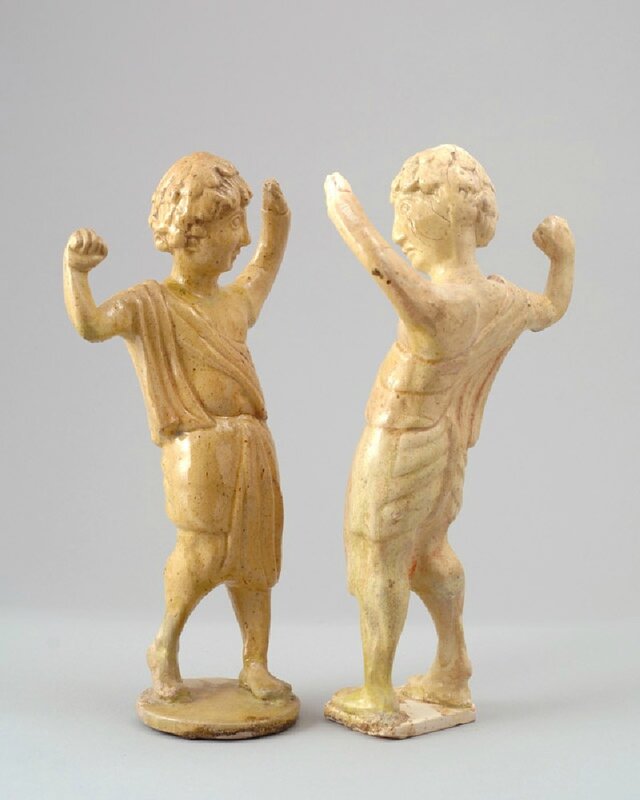Two Figures of a young man, China,Tang dynasty, 7th century AD (AD 601 - 700)
Figure of a young man, China,Tang dynasty, 7th century AD (AD 601 - 700), earthenware, moulded and luted together, and with a transparent glaze, 28.9 x 15.3 x 7.4 cm (height x width x depth). Lent by the Sir Alan Barlow Collection Trust., LI1301.429.1, Ashmolean Museum, Oxford © The University of Sussex
Figure of a young man, China,Tang dynasty, 7th century AD (AD 601 - 700), earthenware, moulded and luted together, and with a transparent glaze, 27.7 x 15.2 x 11.3 cm (height x width x depth). Lent by the Sir Alan Barlow Collection Trust., LI1301.429.2, Ashmolean Museum, Oxford © The University of Sussex
Many foreigners lived and worked in Tang China, particularly in the capital, Chang’an (modern Xi’an in Shaanxi province), but the ethnic background of figures such as the present ones is not easy to establish. A very similar figure, with dark skin, curly hair and similar attire, is depicted in a handscroll of Tribute Bearers in the Nanjing Museum, where it is identified as a man from Langyaxiu A Chinese translation of Langyaxiu, a country in the South China sea in the region of Thailand and Malaysia. The handscroll is a fragmentary copy of the Northern Song dynasty (AD 960–1127), after an original of around AD 539, painted by Xiao Yi, later emperor Yuan of the Liang dynasty (AD 502–557); see (Huaxia zhi lu [A journey into China’s history], Beijing, 1997, vol.II, pls 329–3 centre). Compare also the small figure of a sleeping servant boy in the Barlow collection, which seems to depict a person of a similar ethnic background.
The two figures are modelled from similar moulds, but placed on different pedestals, one circular, the other rectangular. Both are shown with the bodies somewhat contorted, the hips pushed forward, the shoulders back, the head turned to the left, the arms in the air, one hand open, the other tied to a fist. They are identified as foreigners through large round eyes, prominent nose and short, thickly curled hair, and are dressed in a cloth that is draped around the back, twisted between the legs, covering one shoulder like a tunic, and hanging down at the side, leaving bare part of the chest, arms and legs. The figures are made of beige-coloured earthenware and covered overall with a transparent glaze with a strong greenish tinge, with patches of the plinths exposed in the biscuit. The figures would originally have been painted.

/https%3A%2F%2Fprofilepics.canalblog.com%2Fprofilepics%2F1%2F0%2F100183.jpg)
/https%3A%2F%2Fstorage.canalblog.com%2F03%2F02%2F119589%2F96711876_o.jpg)
/https%3A%2F%2Fstorage.canalblog.com%2F11%2F31%2F119589%2F94773502_o.jpg)
/https%3A%2F%2Fstorage.canalblog.com%2F20%2F83%2F119589%2F94772815_o.jpg)
/https%3A%2F%2Fstorage.canalblog.com%2F26%2F72%2F119589%2F75604929_o.jpg)
/https%3A%2F%2Fstorage.canalblog.com%2F59%2F60%2F119589%2F26458628_o.jpg)




/http%3A%2F%2Fstorage.canalblog.com%2F05%2F64%2F119589%2F128523518_o.jpg)
/http%3A%2F%2Fstorage.canalblog.com%2F78%2F46%2F119589%2F127133605_o.jpg)
/http%3A%2F%2Fstorage.canalblog.com%2F99%2F82%2F119589%2F126892955_o.jpg)
/http%3A%2F%2Fstorage.canalblog.com%2F51%2F84%2F119589%2F122518624_o.jpg)